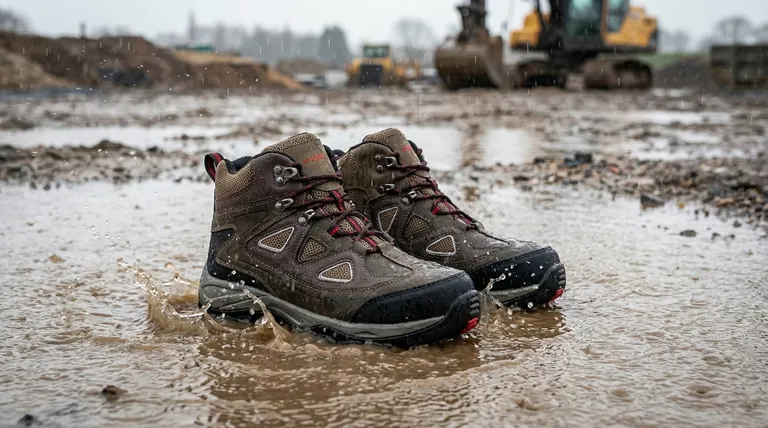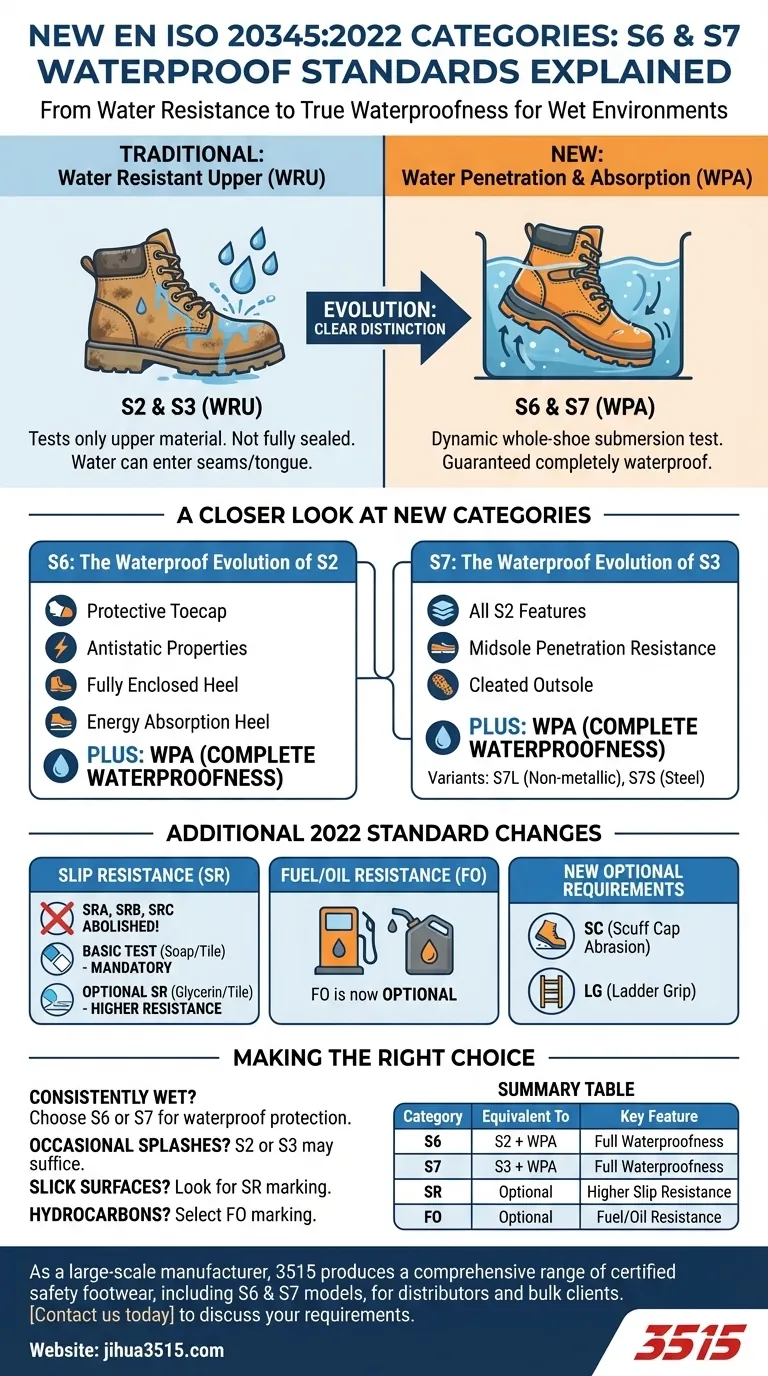The new primary safety footwear categories introduced in EN ISO 20345:2022 are S6 and S7. These classifications were created to specifically address the need for footwear that is not just water-resistant, but fully waterproof. Category S6 is comparable to the S2 standard but with guaranteed waterproofness, while S7 is the waterproof equivalent of the S3 standard, also including midsole penetration resistance.
The core change in the 2022 standard is the creation of a clear distinction between "water resistance," which only applies to the upper material, and true "waterproofness," which tests the entire shoe as a sealed unit. This provides a more accurate and reliable classification for professionals working in consistently wet environments.

The Evolution from Water Resistance to Waterproofness
The introduction of S6 and S7 categories addresses a long-standing ambiguity in safety footwear standards. Previously, the classifications for water protection could be misleading, as they didn't guarantee a completely dry foot in demanding conditions.
The Traditional "Water Resistant Upper" in S2 & S3
Under the old standard, S2 and S3 footwear included a requirement for a "Water Resistant Upper" (WRU). This test, however, only assessed the ability of the upper material itself to resist water penetration.
This meant that water could still potentially enter the shoe through seams, the tongue, or the join between the upper and the sole, especially during prolonged exposure or immersion.
The New Standard: Integrated Waterproofness in S6 & S7
The new S6 and S7 categories mandate a higher level of protection known as Water Penetration and Absorption (WPA).
This involves a dynamic test where the entire shoe is submerged in water and subjected to flexing motions. To pass, the shoe must prevent any water from entering, ensuring the entire product is waterproof, not just its materials.
A Closer Look at the New Categories
The new categories build directly upon the foundations of the familiar S2 and S3 classifications, adding the critical WPA waterproofness requirement.
Category S6: The Waterproof Evolution of S2
A shoe classified as S6 includes all the requirements of the S2 category:
- Protective toecap
- Antistatic properties
- Fully enclosed heel
- Energy absorption in the heel region
- Plus: The new WPA requirement for complete waterproofness.
Category S7: The Waterproof Evolution of S3
A shoe classified as S7 includes all the requirements of the S3 category:
- All features of an S2 shoe
- Midsole penetration resistance
- Cleated outsole
- Plus: The new WPA requirement for complete waterproofness.
The penetration resistance in S7 boots can be achieved with different materials, leading to variants like S7L (non-metallic anti-perforation sole) and S7S (steel anti-perforation sole).
Key Associated Changes in EN ISO 20345:2022
Beyond the new categories, the 2022 update introduced other significant changes that professionals must be aware of when specifying footwear.
The Revision of Slip Resistance (SR)
The previous SRA, SRB, and SRC markings have been abolished. All safety footwear certified under the new standard must pass a basic slip resistance test on a ceramic tile surface with a soap solution.
A new, optional marking, SR, can be achieved if the footwear also passes a more demanding test on a ceramic tile with glycerin. This indicates a higher level of slip resistance for particularly hazardous environments.
Fuel/Oil Resistance (FO) Becomes Optional
Previously, fuel and oil resistance (FO) was a mandatory requirement for S1, S2, and S3 footwear. Under the 2022 standard, it has become an optional feature.
If your risk assessment identifies a need for resistance to fuel or oil, you must now specifically ensure the footwear carries the FO marking.
New Optional Requirements
The update also introduced several new optional codes to specify protection against particular hazards. These include:
- SC: Scuff cap abrasion resistance
- LG: Ladder grip, for enhanced stability on ladders
Making the Right Choice for Your Environment
Understanding these changes is crucial for selecting the appropriate protection. Your choice should be driven by a clear assessment of the specific hazards in your workplace.
- If your team works in consistently wet or submerged conditions: Choose footwear rated S6 or S7 to ensure complete waterproof protection.
- If your primary need is protection from occasional splashes or light rain: Traditional S2 or S3 rated footwear may still be sufficient for your needs.
- If slip hazards on slick or oily surfaces are your main concern: Look for the optional SR marking, regardless of the S-category, for the highest level of certified grip.
- If your environment involves exposure to hydrocarbons: You must now specifically select footwear with the optional FO marking, as it is no longer a default feature.
By understanding the principles behind these new standards, you can make an informed choice that ensures both compliance and true safety.
Summary Table:
| New Category | Equivalent To | Key Feature |
|---|---|---|
| S6 | S2 (Protective toecap, antistatic, heel protection) | Plus Full Waterproofness (WPA) |
| S7 | S3 (S2 features + midsole penetration resistance) | Plus Full Waterproofness (WPA) |
| SR | (Optional) | Higher Slip Resistance |
| FO | (Optional) | Fuel/Oil Resistance (now optional) |
Ensure your team has the right protection for wet and hazardous conditions.
As a large-scale manufacturer, 3515 produces a comprehensive range of certified safety footwear, including the latest S6 and S7 waterproof models, for distributors, brand owners, and bulk clients. Our production capabilities encompass all types of safety shoes and boots tailored to your specific needs and compliance standards.
Contact us today to discuss your safety footwear requirements and get a quote.
Visual Guide

Related Products
- Safety Footwear Wholesale Manufacturer for Custom OEM/ODM Production
- Premium KPU Injection Athletic Style Safety Shoes
- Premium Flame-Retardant Waterproof Safety Boots and Shoes
- Premium Wholesale Waterproof Safety Boots High Performance Protection for Industrial Markets
- Premium High-Cut Waterproof Safety Boots Manufacturing & Wholesale Solutions
People Also Ask
- What are the cultural perspectives on wearing shoes in the house? A Guide to Home Etiquette & Hygiene
- Is it normal to wear shoes in the house? A Guide to Hygiene, Comfort & Culture
- What do heavy duty boots do? Protect Your Feet in Demanding Work Environments
- What cultural and environmental considerations are tied to wearing shoes indoors? Balance Hygiene, Tradition, and Foot Health
- Is safety-toe as good as steel toe? Choose the Right Protection for Your Job



















